Links
Here you'll find advice on how to start your research, with links to Researchers, and Honorary and Research websites, a battlefield Tour Guide Company in Ieper (Ypres) and a helpful Bibliography, containing a short but growing list of books specifically mentioning the 4th CMR. If you come across any other helpful links, books or publications, please let me know and I'll share them here.
If you find any broken links on this page, please do let me know.
Researchers
Arnie Kay for Canadian Military or RCMP research you can do no better than Arnie, who has been of considerable help to me with 4th CMR, 9th Mississuaga Horse and gallantry medal research over the years. If you need somebody "in the know" to help with gaining copies of Canadian military records, citations, or for looking into specific matters of military research, Arnie is your man. Click on Arnie Kay to email him, and please do say where you heard about his services from.
George Auer is one of the researchers who has contributed a good number of detailed and well researched biographies to this site, specifically concerning 147th (Grey) Battalion and 248th Battalion men, who were transferred to the 4th CMR in 1917 and 1918. He has been the link that has allowed many of the extended 4th CMR family to stand beside their relatives.
Incidentally, George has authored two books now, focussed on Grey County, Ontario.
The first, released in 2015, is entitled "Soldiers of the Soil: Grey County goes to War", which tells the personal stories of the men and women of Grey County, Ontario, in WW1.
The second and more recent book is entitled "The Day the Ravebeek Ran Grey", and is a comprehensive look at the genesis and local outcome of one of the most horrific battles of the Great War. A battle officially known as the 3rd Battle of Ypres, but, more commonly known by where it stopped: Passchendaele. October 26th, 1917 was the first day of the Canadian Corps attack. It was also a day that would become the seminal point in Grey County's military history. With the number of Grey County soldiers at the front at its zenith, the two battalions containing the highest number of Grey County soldiers simultaneously attacked Belleview Spur. On the 9th Brigade's right flank the 58th Battalion would attack with the Ravebeek Creek on their right. While on the far left flank of the Canadians Corps, two officers originally from the 147th (Grey) Battalion would lead the assault for the 4th Canadian Mounted Rifles and the 8th Brigade. Thirty-seven Grey County men would perish and a Victoria Cross would be won.
Both books are being carried by The Ginger Press and would make ideal additions to a WW1 study collection or as gifts.
Honorary and Research Websites
1st Canadian Mounted Rifles - Peter Maxfield has provided this link to his building work on the 1st CMR. With the War Diaries transcription well under way, this link provides access to a growing set of photos and artifacts that aspires to be the basis of a proposed 1st C.M.R. website. Recent additions include a panoramic glass plate of the officers and men outside Brandon Armoury in early 1915, and scans of a handwritten Nominal Roll of "A" Squadron (Company).
Peter Maxfield is a grandson of Major (Lt-Col) W.E.Maxfield D.S.O. (won at Vimy Ridge). 4cmr.com wishes Pete all the best for the coming website and invites 4cmr.com visitors to support the work in progress by dropping in to see the material and records concerning this sister CMR regiment.
2nd Canadian Mounted Rifles - a tribute website in honour of 227635, Pte Ernest Henry Borrow. 4cmr.com also wishes this sister CMR regiment site well.
Battle for Mount Sorrel - is a very useful link to Chris Baker's 'The Long, Long Trail' website, for a very detailed account of the June 2nd, 1916, Battle for Mount Sorrel; a devastating day in the history of the 4th CMR. Once on the page this link takes you to, scroll down to 'The Battle of Mount Sorrel, 2-13 June 1916'
The Canadian Great War Project, run by the helpful Marc Leroux, is intended to promote interest in Canada's participation in World War 1, and to research the Canadians and other nationalities who served with the CEF in the First World War.
CEF Soldiers' Attestation Papers can also be accessed on 'ArchiviaNet', part of 'Library and Archives Canada'. This searchable database provides digital images of a soldier's attestation papers. Unlike the CWGC (below) this is for ALL Canadian soldiers, not just those who were lost. If they signed on with the CEF, chances are you should be able to locate their attestation papers here.
The Canadian Expeditionary Force Study Group is a website administered by Neil Burns, and brings together a group of enthusiasts interested in the widest range of aspects concerning the CEF in WW1. They run a very helpful Forum, where you will receive a warm welcome and an open door to reach people who want to help with any query you might have.
Commonwealth War Graves Commission - the CWGC is doing immeasurably invaluable work to commemorate the war dead, through the building and maintenance of cemeteries and memorials around the word, and with the preservation of records. A 'Find War Dead / Find a Cemetery'' search facility is available on the Homepage, to track down individuals or places of rest.
Faces of Holzminden is a book dedicated to illuminating the personal stories of the officer POWs held in the notorious Kaserne Holzminden camp, in Lower Saxony, Germany, between September 1917 and December 1918. Linked to an up and coming feature film, entitled "The Enemy Within" which dramatises the famous Allied tunnelling escape of July, 1918, Faces of Holzminden is aiming for a release to coincide with the centenary anniversary of the commencement of the Great War in 2014.
If a relative or research subject spent any time at Holzminden, or even if they didn't, do drop in on this fascinating body of work, lend your encouragement to its progress, and contribute if you can via the email addresses on their website of via their Facebook page.
The Governor General's Horse Guards perpetuates the 4th CMR today as part of the 32nd Canadian Brigade Group.
Originally formed as a troop of dragoons in 1822, the troop became independent of its parent battalion in 1839, and was named the Governor General's Body Guard in 1866. The GGBG had an illustrious history to 1914, when along with the 9th Mississuaga Horse, the 2nd Dragoons and the 25th Brant Dragoons, 28 officers and 577 non-commissioned officers and men formed the 4th Canadian Mounted Rifles. After WW1, the GGBG and the 9th Mississuaga Horse combined to perpetuate the 4th CMR as The Governor General's Horse Guards in 1936. The regiment went on to see action in Italy and NW Europe in WW2.
The regiment has an active Association, so please do visit the GGHG website and that of the Association, to learn more about their history and current active service.
Hellfire Corner is a fantastic site to get Great War news and information, which also links into Tom Morgan's own superb on-line military books sales service. There are lots of specialist and general interest articles by many contributors, and this site is well worth a look-see in respect of its prominence and length of service in providing a point of focus for the Great War on the web.
Maple Leaf Legacy Project (MLLP), receives a special mention here, as its goal is to image every Canadian headstone of the 20th Century around the world. The project is run by Steve Douglas, who also owns and runs a great bookshop in Ieper that you must visit, 'The British Grenadier Bookshop', on Meensestraat - the main walk up to the Menin Gate from the town - and the 'Salient Tours', battlefield tour company.
The MLLP's success is due to a large, multi-national volunteer force, which I have the pleasure being a part of. The project's website has a searchable database to help find an image of a particular Canadian headstone.
Matrix Project blogs. Richard Laughton manages the Matrix Project - formed by members of the Canadian Expeditonary Force Study Group - which creates blogs about men who served with the CEF in the Great War. A stunning body of work and collective research, which will be of great value and interest to anybody wishing to learn more about the men who served with the CEF.
World War in-depth - BBC - World War One is a detailed and very informative website, taking a look at all aspects of WW1, and also includes a virtual tour of the trenches. There is a good deal of detail and subject focus for all levels of interest in the "war to end all wars".
Battlefield Tour Guide Company
Salient Tours runs professionally organised and informatively guided tours in the Ypres and Somme areas, Salient Tours is dedicated to helping people understand the events of the First World War, whether through their guided tours, their specialist bookshops at Ypres and on the Somme, or simply through offering advice and information.
Bibliography
This is a list of books or publications (printed or web based), which specifically mention the 4th CMR. This list is fledgling, and I welcome your contributions to it.
4th Canadian Mounted Rifles - S. G. Bennett - Murray Printing Company Ltd, Toronto - 1926 - is a Regimental History, with a full and detailed account of the 4th CMR from 1914 to 1919. A rare and expensive book. Grab it if you see it.
Alternatively, this book is available, free, on-line: 4th CMR Regimental History will take you there. Select from any of the varied formats now available from the menu on the left of their page. An invaluable development for 4th CMR researchers.
An American Soldier - Houghton Mifflin Co, USA - 1918 - A collection of letters from Lt Edwin Austin Abbey to his family. Lt Abbey was assigned to the 4th CMR in December 1916, following his return to the Front from England after being wounded. He fell at Vimy Ridge in April 1917. An interesting account of an American who, eager to join the war, does so like many others via Canada, who then falls at the largest of the Canadian victories.
This book is available, free, on-line: An American Soldier.
Captured - Lt J. Harvey Douglas - McClelland, Goodchild & Stewart Ltd, Toronto - 1918 - written by Lt Douglas, who also survived the onslaught of June 2nd 1916, and too was taken as a POW. He was held for the next 16 months, finally being interred in Switzerland before being repatriated in late 1917. This book is in contrast to that of McMullen & Evans, in that the life of an officer POW was somewhat different to that of the ordinary soldier.
This book is available, free, on-line: Captured.
Clarence McCabe - A Canadian Soldier of the First World War - by Bryan Joyce, is a well written biography, giving a further and valuable insight into the lives of ordinary men joining up to fight in the Great War. Clarence McCabe's story is one of leaving farm home life and with the 4th CMR enduring some of the most significant action in Europe, only to be lost to a most unfortunate accident. In 52 pages, this is a detailed and moving biography. 4cmr.com highly recommends this well researched book and is available through Blurb.com.
The Day the Ravebeek Ran Grey - George Auer - Ginger Press - is a comprehensive look at the genesis and local outcome of one of the most horrific battles of the Great War. A battle officially known as the 3rd Battle of Ypres, but, more commonly known by where it stopped: Passchendaele. October 26th, 1917 was the first day of the Canadian Corps attack. It was also a day that would become the seminal point in Grey County's military history. With the number of Grey County soldiers at the front at its zenith, the two battalions containing the highest number of Grey County soldiers simultaneously attacked Belleview Spur. On the 9th Brigade's right flank the 58th Battalion would attack with the Ravebeek Creek on their right. While on the far left flank of the Canadians Corps, two officers originally from the 147th (Grey) Battalion would lead the assault for the 4th Canadian Mounted Rifles and the 8th Brigade. Thirty-seven Grey County men would perish and a Victoria Cross would be won.
See "Soldiers of the Soil: Grey County goes to War" below, also by George Auer.
The Governor General's Horse Guards - Second to None - John Marteinson - RBS 2002 - is the story of Canada's senior militia regiment. A book containing rich narrative and plentiful in maps and photographs, this book has a depth of detail rarely found in regimental histories. The book covers the period from the regiment's earliest roots to its activities as at 2001.
Relevant to the 4th CMR is the extensive section on the First World War, with an in-depth focus on the darkest days of the regiment in the Battle for Mount Sorrel in June, 1916, and its involvement in the pivotal actions on the Somme, at Vimy Ridge, Passchendaele, Amiens, and the final 100 days of the war at Arras, Cambrai and finally when the Armistice was announced, at Valanciennes (8km from Mons). The 4th CMR marched into Mons on November 12th, 1918. The war was over.
Whilst I am sure the book will be available through the 'Kit Shop' section of the GGHG's Association website in due course, for now any enquiries for the purchase of the book should be put through to the Kit Shop's email. This exceptional book is a MUST for 4th CMR researchers at all levels.
The Malcolm MacPhail WW1 book series, by Canadian author, Darrell Duthie
The books are displayed below, along with their Amazon promotional descriptions and 4cmr.com comments, and are available (including a Kindle format) through Amazon: click here for links to Amazon.com and for UK Amazon.co.uk.
Book 1 - Malcolm MacPhail's Great War - published in November 2017
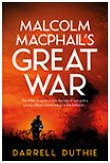
"Fall 1917. The Western Front is in stalemate. Captain Malcolm MacPhail of the Canadian Corps has been in the trenches for longer than he cares to remember. He's just landed a new job on the intelligence staff, but if he thinks staying alive is going to become any easier, he's sorely mistaken.
The rain is pelting down, the shells are flying and the dreaded battle for Passchendaele looms. Malcolm reckons matters can still get worse. Which proves to be an accurate assessment, especially as his unruly tongue has a habit of making enemies all on its own.
The Allies are fighting desperately to swing the tide of war, and Malcolm's future hangs in the balance, so keeping his head down is simply not an option..."
The book sees the 4th CMR appear in the latter stages of the book, with spotlights on two of its officers: Captain Beecher Poyser MC and Captain Thomas Dixon MM MC.
Book 2 - My Hundred Days Of War - published in October 2018
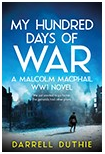
"August 1918. Amiens, France. Allied armies have driven a massive hole in the German lines. But the enemy is regrouping. Major Malcolm MacPhail of the Canadian Corps is an intelligence officer, a veteran of countless battles and too outspoken for his own good. Now he's worried. Every Fritz on the Western Front seems headed their way, bent on preventing the breakthrough that might just end the war.
As the attack resumes and friends start to fall, Malcolm fears his own luck may finally be running out. It doesn't help that he's somehow stomped on another general's toes. So when captured German booty goes mysteriously missing, and the nephew of an old nemesis appears with searching questions for him, the dangers at headquarters suddenly rival those of the battlefield.
The Great War is entering a pivotal and deadly new phase. For Malcolm, even victory may not be enough"
The 4th CMR makes another, if not brief appearance in the novel.
Book 3 - A War for King and Empire - published in January 2020
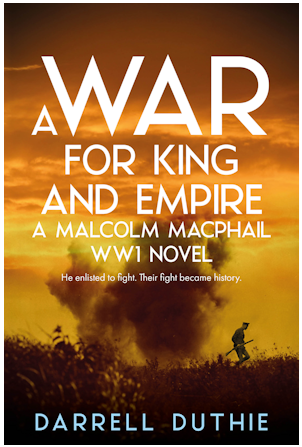
"In early 1915 a young soldier, Malcolm MacPhail, arrives on the Western Front in the dreaded Ypres Salient. As the Germans press the attack, Malcolm and his inexperienced comrades must fight for their lives if they are to stave off a disastrous defeat. If war wasn't bad enough, a shady acquaintance from home turns up, looking to quarrel and concealing a secret he's prepared to defend at any cost. Gripping and authentic historical fiction about the hard-fought first years of the Great War.".
Incidentally, the 4th CMR makes a brief appearance on their own darkest of days in mid-1916.
Book 4 - Vicissitudes of War - published in October 2020
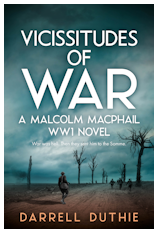
"A novel of the Somme and Vimy Ridge - War was hell. Then they sent him to the Somme.
September 1916. The Battle of the Somme is raging. Newly-promoted lieutenant Malcolm MacPhail arrives in Albert, France feeling himself lucky to have left behind the sodden trenches of the Salient. Until he glimpses the battlefield. The Boche guns are thundering something fierce, the ground for miles around a barren wasteland. If the rumours are true a new offensive is only days away.
Malcolm has yet to prove himself as an officer - and chances are he'll need to do it in a mad charge across No-Man's-Land. When an old rival joins the battalion, and discovers the secret Malcolm holds, not just life and limb but career and honour are at stake.
The Great War is thundering on, the Allies determined to force the elusive victory, and the Germans unwilling to yield an inch. Malcolm and his countrymen have their orders. But can they succeed where so many others have failed?"
The 4th CMR is featured in an action before the attack on Vimy Ridge. Indeed, the 1st, 4th and 5th Canadian Mounted Rifles get collective mentions in the book.
Book 5 - A Summer for War - published in November 2021
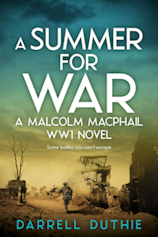
"Some battles you can't escape…
The summer of 1917. Near Lens, France. The vaunted Vimy Ridge has been taken. Lieutenant Malcolm MacPhail has settled into his position on the divisional staff. Yet there will be no peace for him and his comrades this summer. Far from being on their last legs the enemy is fighting with fresh tenacity. The campaign near Arras grinds on.
At headquarters, rivals have surfaced amongst the staff, his superiors are impossible to please, and mysterious goings-on behind the lines could explode into scandal. When Malcolm offhandedly alienates a brigadier and his adjutant, the consequences for him and his closest friend are far-reaching.
Meanwhile the field-marshal's eyes have shifted north. His new offensive requires a diversion and he orders the Canadian Corps to capture the key crossroads of Lens. However a single fortified hill stands in the way. As the threats mount, Malcolm must focus on the coming battle, which could be the key to everything…"
I highly recommend these books, as they do put you into the thick of the CEF action in the various stages of the war. Darrell does a fantastic job of maintaining the pace and tension of actions at the front at that time. The extent of the research is breathtaking, as is evident in the locations, the command hierarchy and the detail of the actions described. If you enjoy WW1 fiction, these well written books are for you, and would be excellent gifts for somebody you know who is interested in the First World War.
These books (including Kindle format) are available through your usual Amazon supplier. Just search for "Darrell Duthie" or "A Summer for War".
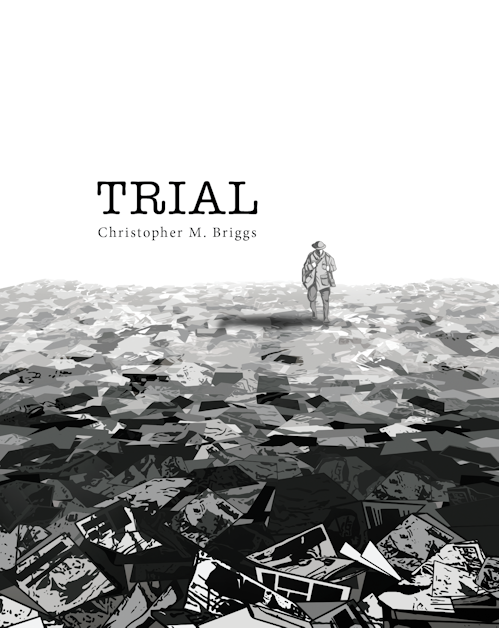
Trial, by Christopher M. Briggs, is a WW1 story that centres on the true events of the Currie Libel trial of 1928, which saw General Sir Arthur Currie suing the Port Hope Evening Guide newspaper over a front page accusation that he was responsible for thousands of Canadian casualties on the last day of the war.
Principal characters are Sir Arthur Currie, Canadian Corps commander, who, finding his reputation thanklessly assaulted, seeks to find redress in a libel action against the newspaper. The fictionalised story woven around this actual trial concerns one of Sir Arthur's lawyers, Alfred Simpson. A wounded veteran, who had served as Captain with the 9th Canadian Mounted Rifles in the war, Alfred was invalided out of the conflict due to injuries sustained near Amiens in the late summer of 1918. Alongside him after the war is his wife, Sarah, who is struggling to deal with her husband's increasingly estranged behaviour, which only serves to push her away and into the arms of another.
During the court action, a time in which Alfred is battling his own injury induced demons as well as struggling with a failing marriage, the story switches well between the trial, which was seen as much as putting the Great War on trial as it was Sir Arthur's reputation, the front line action which Alfred saw right up to his war ending injuries, and Sarah as she seeks the attention and solace of another man in the burgeoning progressive society of the late 1920s.
Christopher Brigg's research of the trial was meticulous and holds the tension well for both sides of the argument. The wartime actions that Alfred saw (here based upon a fictionalised version of the 4th CMR - although the 9th CMR was authorized and sailed to England in late 1915, it was absorbed by other regiments in the divisional restructuring of January 1916 and never saw action in its own right), were riveting in their portrayal of the tediousness and horror of trench warfare. The depictions of late 1920s social life and the changing attitudes of the time were simply captivating.
The attention to detail in the novel is outstanding and I would highly recommend it to anyone interested in a unique take on the Great War. Tension and pace is maintained through to the end, where the inevitable questions as to whether Sir Arthur's reputation will be saved, or Alfred's battle to defeat his demons is won, or whether Sarah remains loyal to her husband, are answered in a well crafted conclusion.
The book (an eBook version will be available in due course) can be further reviewed and bought here at: Trial - The Soapbox Box Press.
Out of the Jaws of Hunland - McMullen & Evans - William Briggs, Toronto - 1918 - written by Cpl Fred McMullen and Pte Jack Evans, who both survived the Battle for Mount Sorrel on June 2nd 1916, and were subsequently taken prisoner. An amazing tale of their survival of that awful day, their capture, life as POWs, their escape bids, and final escape into The Netherlands.
This book is available, free, on-line: Out of the Jaws of Hunland.
Prisoner 5-1-11 - Norm Christie - CEF Books © 2006 - The personal recollections of 112079, Pte Harry Laird's joining up, training, posting, life in the trenches, his survival of the Battle of Mount Sorrel on June 2nd, 1916, his wounding, subsequent capture, and life as a POW. This is an amazing account of that most horrendous of times for the 4th CMR, and is told in vivid and often harrowing detail. It is clear from this account that those few who survived June 2nd, 1916, were indeed miracles in their own right. Written in 1919, this memoir hides none of Harry Laird's bitterness, who wrote it "like it was", that is honest to his feelings in that immediate post-war period. For Harry's picture of what June 2nd, 1916, was like, life as a wounded and slow to recover POW, and the sheer indignation that some soldiers felt about their treatment in captivity, you must read this book.
Soldiers of the Soil: Grey County goes to War - George Auer - Ginger Press - tells the personal stories of the men and women of Grey County, Ontario, in WW1.
See "The Day the Riverbeek Ran Grey" above, also by George Auer.